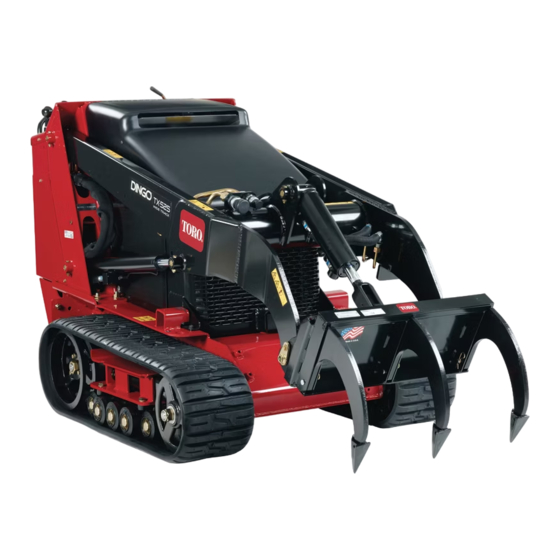
Table of Contents
Advertisement
Quick Links
TORO DINGO 525
COMPACT UTILITY LOADER
OPERATOR'S MANUAL LOCATED
IN WEATHER TITE BOX.
Safety
Improper use or maintenance by the operator
or owner can result in injury. To reduce
the potential for injury, comply with these
safety instructions and always pay attention
to the safety alert symbol
A,
which means:
Caution, Warning, or Danger-personal
safety instruction. Failure to comply with the
instruction may result in personal injury or
death.
Safe Operating Practices
This product is capable of amputating hands and
feet. Always follow
all
safety instructions to avoid
serious injury or death.
Engine exhaust contains carbon monoxide,
an odorless, deadly poison that can kill you.
Do not run the engine indoors or in an
enclosed area.
Training
• Read the Operator's Manual and other training
material. If the operator(s) or mechanic(s) can
not read English, it is the owner's responsibility
to explain this material to them.
Slope Operation
Slopes are a major factor related to loss-of-control
and tip-over accidents, which can result in severe
injury or death. All slopes require extra caution.
• Do not operate the traction unit on hillsides
or slopes exceeding the angles recommended
in the Stability Data section in Specifications,
page 17, and those in the attachment Operator's
Manual See also the Slope Chart, page 8.
• Operate up and down slopes with the
heavy end of the traction unit uphill.
Weight
distribution changes. An empty bucket will
make the rear of the traction unit the heavy
end, and a full bucket will make the front of
the traction unit the heavy end. Most other
attachments will make the front of traction
unit the heavy end.
Controls
Become familiar with
all
the controls (Figure 4)
before you start the engine and operate the traction
unit.
10
9
Figure 4
1. Auxiliary hydraulics lever
6. Throttle lever
2. Key switch
7.
Loader arm/attachment tilt
lever
3. Hour meter
8. Parking brake lever
4. Fuel gauge
9.
Reference bar
5. Indicator lights and glow 10. Traction control
plug switch
Reference Bar
When driving the traction unit, use the reference
bar as a handle and a leverage point for controlling
the traction control and the auxiliary hydraulics
lever. To ensure smooth, controlled operation, do
not take both hands off of the reference bar while
operating the traction unit.
Traction Control
To move forward, move the traction control
forward. To move rearward, move the traction
control rearward (Figure 5).
To
turn
rotate the traction control in the desired
,
direction (Figure
5).
The farther you move the traction control in any
direction
,
the faster the traction unit will move in
that direction.
To stop, release the traction control.
Figure 5
I
Advertisement
Table of Contents








Need help?
Do you have a question about the DINGO 525 and is the answer not in the manual?
Questions and answers